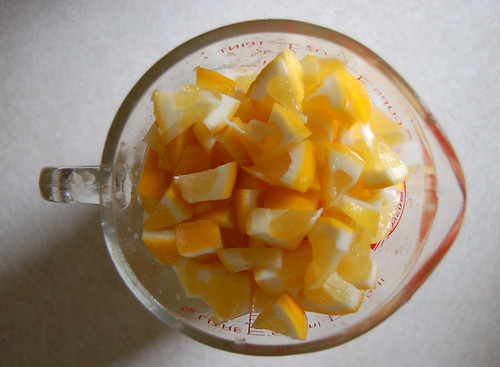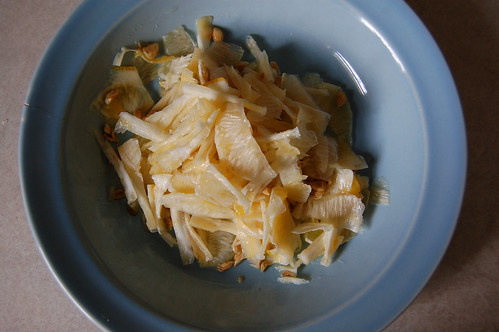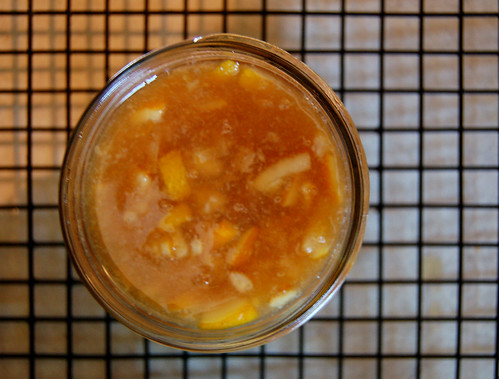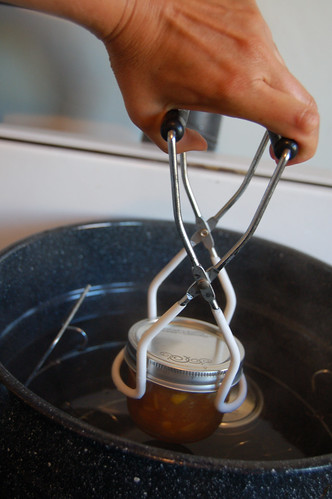Bittersweet
...
Friday was a sad day, because I spent most of it helping Sheri and Kyle pack for their move to Portland. At the end of the day, we walked over to the vacant house next door and picked a bag-full of fruit.
Today, while Sheri and Kyle were driving north, I taught myself to make meyer lemon marmalade.
Want to learn how? It's remarkably easy.
You'll need six cups of chopped lemons. Cut the ends off of the lemons, and then slice them into segments, and then small triangles.
As you're slicing, remove any membranes that are easy to get to, and save them and all the seeds. This will be a source of pectin, which will help your marmalade jell.
Tie the membrane and seeds inside of a piece of cheesecloth and toss this into a large stock pot with the six cups of lemons and six cups of water. I buy cases of medical grade cheesecloth for work, but you can get regular cheesecloth at the grocery store. Depending on how fine or loose the weave is, you may need to layer the fabric to hold the seeds in. If you're cutting cheesecloth to size, give it a very good shake, so that you don't have stray threads that will come loose while you cook. Nobody wants that kind of extra fiber in their diet.
Boil all this, over medium heat, until the lemon peels get soft. (Soft, but not cooked to death. To quote Shuna at Eggbeater, "you are not making mush.") This should take about twenty minutes.
While the lemons are cooking, put a stack of small plates in the freezer. I'll explain why in a moment.
When the lemons have softened, remove the cheesecloth bag. I hung mine on the edge of the stockpot with a wooden clothespin, and when it had drained, I stuck it in the freezer for a moment.
When it is cool enough to handle, squeeze the bag over the stockpot. This will release the pectin, which will have a creamy-slimy texture. Be smarter than I was, and take your rings off before you start. You'll probably need to scrape your hands with a spoon or rubber spatula. This is the messiest part of the process, but it's also very tactile and satisfying.
Add six cups of sugar to the cooked lemons, and boil for another fifteen minutes or so.
Wash your "canning" jars. Set them in a big stockpot full of water, and let the water simmer. Let the jars and water heat up together. Don't drop glass into boiling water. Also simmer the lids of the jars (but not the rings). This recipe will make about eight half-pint jars. Use actual "canning" jars, because these jars will give the best seal. A poor seal may result in spoiled marmalade. This should be a very safe, long-lasting jam, because it has a lot of acid and a lot of sugar.
After your marmalade has cooked for fifteen minutes, you want to start testing to see if it has "set up." Take one of your chilled plates out of the freezer, and spoon out a dollop of boiling hot marmalade.
Push the spoon through the marmalade. If it glides through smoothly, you need to keep cooking. Lick the spoon. Lick the plate. Lick your fingers. Oh, yeah...
If the jam wrinkles, like in this photo, you're all set.
(This is without a doubt the dullest photo I've ever shared on the blog.)
Carefully fish your jars out of their water bath, and drain them. I use a set of jar-lifting tongs, because I think they make this process a lot safer. Ladle marmalade into jars, leaving about a quarter of an inch of "head space." The jars' threading offers an easy increment of measure. Fill to the top of the threading. Wipe off any drips with a clean damp paper towel.
Place the lid on, and then screw on the sealer rings. You want to screw on firmly, but not insanely tight. Hold onto the jars with a towel, because they are still boiling hot.
Carry the jars back to the hot water bath, and boil the jars for ten more minutes. This will give the final seal to the jars. Set them on a cooling rack overnight. You should hear the jars "pop" when the seal sets up. If the tops of the jars flex the day after you process them, you can re-boil them for a better seal.
Not bad, for a first attempt!
Friday was a sad day, because I spent most of it helping Sheri and Kyle pack for their move to Portland. At the end of the day, we walked over to the vacant house next door and picked a bag-full of fruit.
Today, while Sheri and Kyle were driving north, I taught myself to make meyer lemon marmalade.
Want to learn how? It's remarkably easy.
You'll need six cups of chopped lemons. Cut the ends off of the lemons, and then slice them into segments, and then small triangles.
As you're slicing, remove any membranes that are easy to get to, and save them and all the seeds. This will be a source of pectin, which will help your marmalade jell.
Tie the membrane and seeds inside of a piece of cheesecloth and toss this into a large stock pot with the six cups of lemons and six cups of water. I buy cases of medical grade cheesecloth for work, but you can get regular cheesecloth at the grocery store. Depending on how fine or loose the weave is, you may need to layer the fabric to hold the seeds in. If you're cutting cheesecloth to size, give it a very good shake, so that you don't have stray threads that will come loose while you cook. Nobody wants that kind of extra fiber in their diet.
Boil all this, over medium heat, until the lemon peels get soft. (Soft, but not cooked to death. To quote Shuna at Eggbeater, "you are not making mush.") This should take about twenty minutes.
While the lemons are cooking, put a stack of small plates in the freezer. I'll explain why in a moment.
When the lemons have softened, remove the cheesecloth bag. I hung mine on the edge of the stockpot with a wooden clothespin, and when it had drained, I stuck it in the freezer for a moment.
When it is cool enough to handle, squeeze the bag over the stockpot. This will release the pectin, which will have a creamy-slimy texture. Be smarter than I was, and take your rings off before you start. You'll probably need to scrape your hands with a spoon or rubber spatula. This is the messiest part of the process, but it's also very tactile and satisfying.
Add six cups of sugar to the cooked lemons, and boil for another fifteen minutes or so.
Wash your "canning" jars. Set them in a big stockpot full of water, and let the water simmer. Let the jars and water heat up together. Don't drop glass into boiling water. Also simmer the lids of the jars (but not the rings). This recipe will make about eight half-pint jars. Use actual "canning" jars, because these jars will give the best seal. A poor seal may result in spoiled marmalade. This should be a very safe, long-lasting jam, because it has a lot of acid and a lot of sugar.
After your marmalade has cooked for fifteen minutes, you want to start testing to see if it has "set up." Take one of your chilled plates out of the freezer, and spoon out a dollop of boiling hot marmalade.
Push the spoon through the marmalade. If it glides through smoothly, you need to keep cooking. Lick the spoon. Lick the plate. Lick your fingers. Oh, yeah...
If the jam wrinkles, like in this photo, you're all set.
(This is without a doubt the dullest photo I've ever shared on the blog.)
Carefully fish your jars out of their water bath, and drain them. I use a set of jar-lifting tongs, because I think they make this process a lot safer. Ladle marmalade into jars, leaving about a quarter of an inch of "head space." The jars' threading offers an easy increment of measure. Fill to the top of the threading. Wipe off any drips with a clean damp paper towel.
Place the lid on, and then screw on the sealer rings. You want to screw on firmly, but not insanely tight. Hold onto the jars with a towel, because they are still boiling hot.
Carry the jars back to the hot water bath, and boil the jars for ten more minutes. This will give the final seal to the jars. Set them on a cooling rack overnight. You should hear the jars "pop" when the seal sets up. If the tops of the jars flex the day after you process them, you can re-boil them for a better seal.
Not bad, for a first attempt!













Comments
i don't even like marmalade and found it interesting.
Lisa, I love that you did all this from rescued fruit from an abandoned home. We try to find these sources of free food hereabouts. It's amazing what goes ignored, left to rot, because we're all busy at the grocery store. Great post!
I thought I didn't like marmalade until I made Myer Lemon marmalade. Storebought just can't compete. Lovely clear photos and it sounds like a satisfying way to deal with a sad event.
Stacey